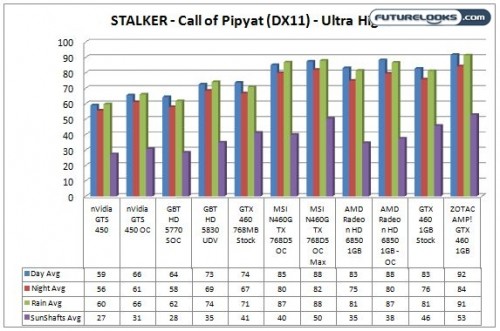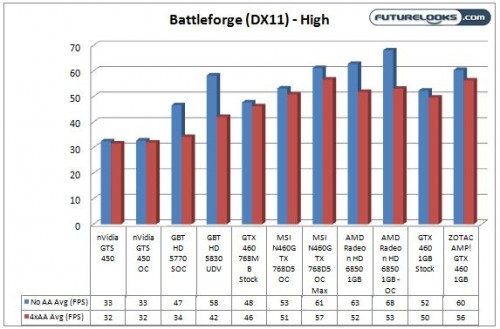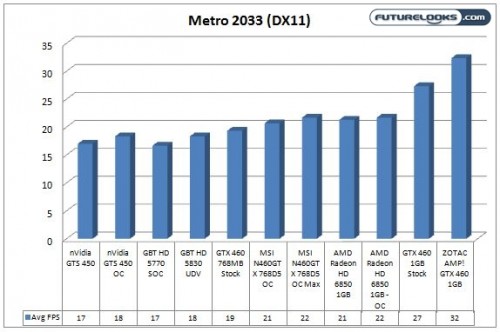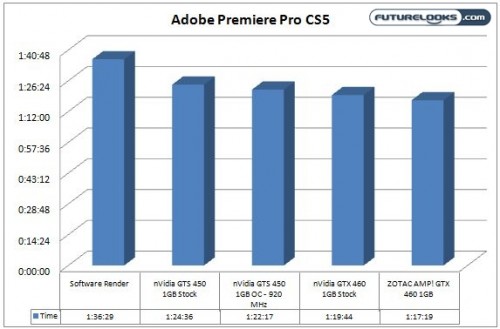STALKER – Call of Pipryat (DX11)
We cranked things up to Ultra High and let STALKER do its thing. At the end of the runs we are looking at the increased memory bandwidth of the ZOTAC AMP! Edition winning the day, but not far behind at all is the MSI N460GTX. The overclock only puts it a few FPS behind. The HD 6850 gets beat up in the Sunshafts section of the benchmark quite heavily.
Alien Vs. Predator (DX11)
Alien Vs. Predator is an older DX11 title, but its built in benchmarking tool still makes it valuable for assessing performance between video cards. Here we see the HD 6850 defend its price point well against a cheaper and more expensive adversary. However, the additional memory bandwidth of the ZOTAC AMP! Edition clearly wins the day in this benchmark.
Battleforge (DX11)
Battleforge is one of the RTS titles we rely on because it’s not only totally brutal, but it’s one of few RTS games that comes with its own benchmarking utility. Using that benchmark, we can see that this AMD sponsored title clearly favours the HD 6850 when you turn off the AA. Turn it on though, and the nVidia cards take over. We also notice that the very overclocked MSI N460GTX at 895MHz core really takes it to the ZOTAC AMP! Edition in both AA on and off tests.
Metro 2033 (DX11)
Metro 2033 is a totally brutal title that destroys weak video cards. Every card except the ZOTAC AMP! Edition failed to hit 30 FPS. This is a huge win for the extra memory bandwidth of the ZOTAC’s 1GB powered GTX 460. It makes me wonder if the 2GB version that ZOTAC has waiting in the wings makes a difference in this title. If I was to replace Crysis tomorrow, I’d replace it with this benchmark in a heart beat.
This concludes our game engine benchmarks. As you can see from many of the results, the bargain basement priced MSI N460GTX Cyclone 768D5 OC Edition really does well when taken to the limit. It nearly matches the overclocked and more expensive ZOTAC AMP! Edition GTX 460 1GB in more than a few instances, and really puts the hurt on the HD 6850 whether overclocked or not, especially when it comes to PhysX titles. The best part was how easy it was to overclock and make stable thanks to the voltage adjustment.
Extra Credit: Adobe Premiere Pro CS5 Mercury Playback Engine Benchmark
We introduced this benchmark in our original nVidia GTS 450 launch review. While Adobe Premiere Pro CS5 does offer official and growing support for nVidia cards, it currently offers no support for AMD, which is really disappointing. However, the Adobe doesn’t currently support anything below the GTX 470 so what many people have done is taken less expensive GPUs that meet the requirements of having 1GB or more of memory and hacking a configuration file to make it work. Does a higher end GPU help out though? Let the results speak for itself.
Clearly, the ZOTAC AMP! Edition is the one to go for based on the number one reason why you buy a factory overclocked card: reliable and guaranteed overclock. Since Adobe Premiere Pro CS5 is a monster non-linear editing suite for video production, it really puts the hurt on your hardware different than a game. The overclocked ZOTAC AMP! Edition clearly takes time off our render using our test file. Since the time is expressed in minutes/seconds, imagine how many hours you would save over the course of the year if you were doing a lot of projects and how crappy it would be if you overclocked your card only to have it crash in the middle of getting important projects done.





